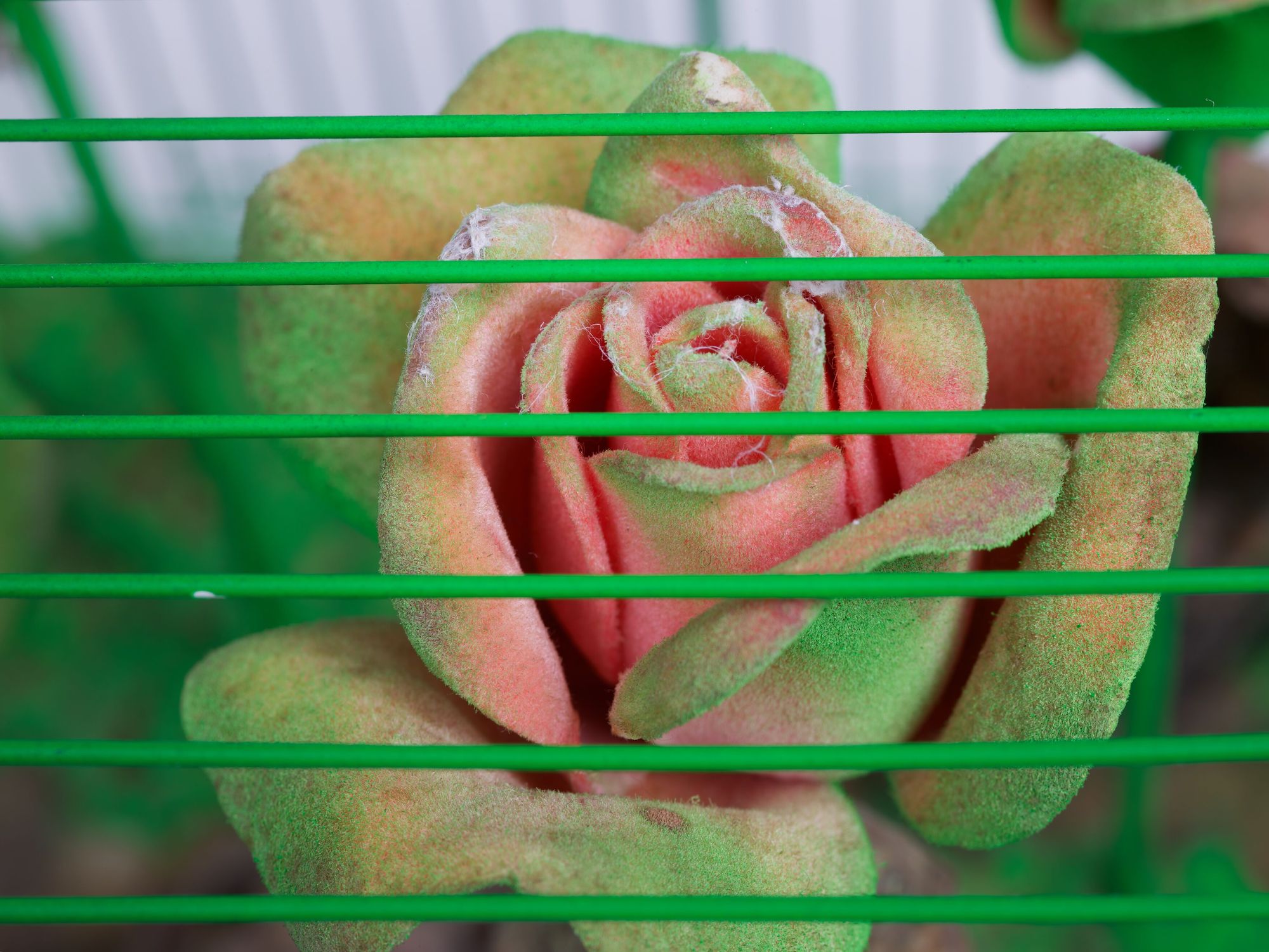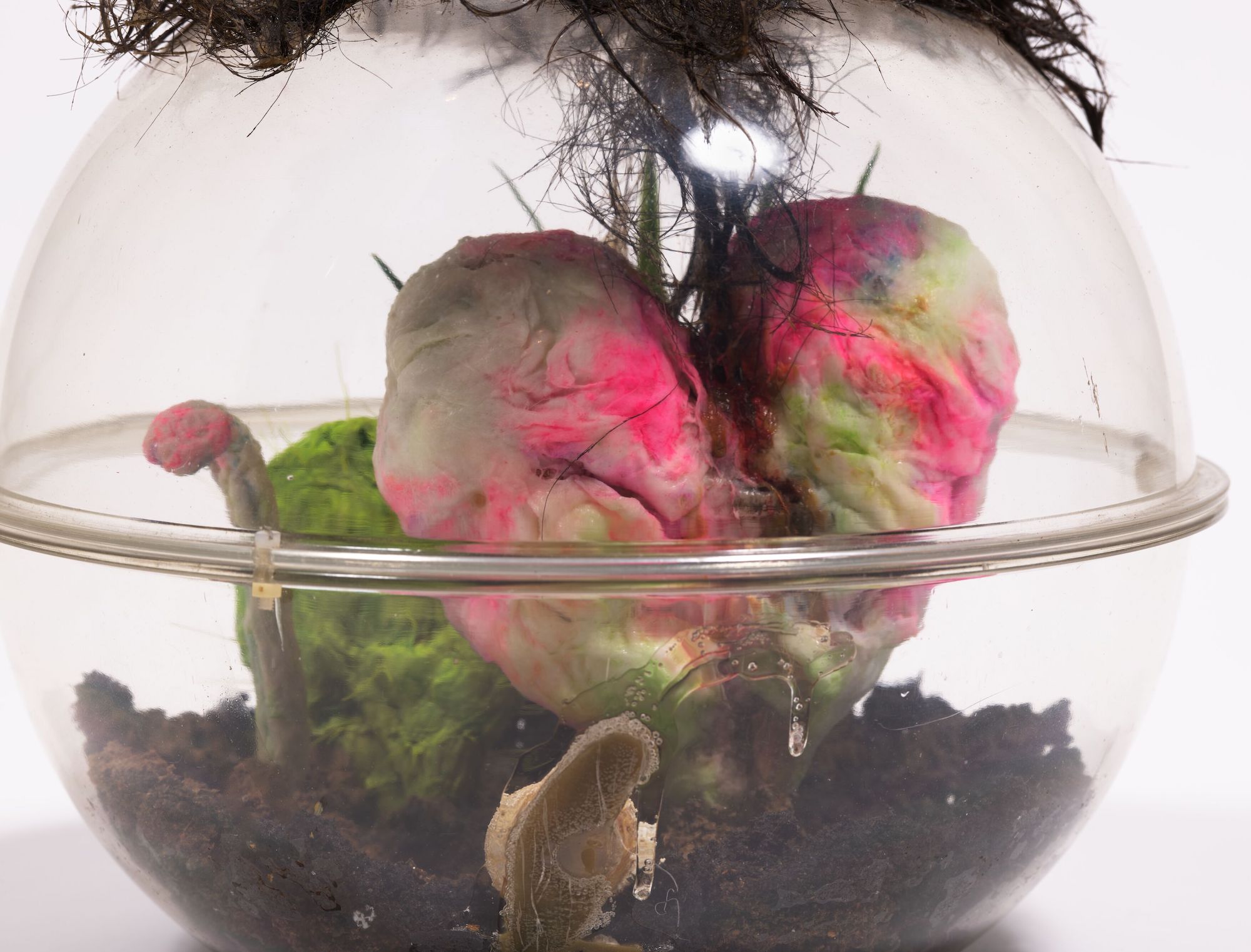Environment (n.)
Tetsumi Kudo, Cultivation of Nature & People Who Are Looking at It, detail, 1970-1971, plastic bucket, mirrored glass, cotton, artificial soil, resin, adhesive, paint, transistors, 14 1/8 x 9 inches [photo: Thomas Barratt; courtesy of Hiroko Kudo, the Estate of Tetsumi Kudo © 2021 Artists Rights Society (ARS), New York / ADAGP, Paris]
Share:
The poet Theognis, back around the sixth century BCE, celebrated the octopus for its “ingenuity” in mimicking “the color of whatever stone it sticks to.” I wot not circumflexions and environments, decried Plutarch 700 years later, discoursing, via poor Theo’s choice metaphor, on friendship versus flattery. Or so reads one 17th-century translation, obscure but tantalizing for that little tick: environments, in this assonating sample, describing the act of circling, encompassing, being encompassed.
In 1603, to environ was a thing one could say: a verb meaning to inhabit, to settle. Language being no such site. Language being, to borrow a more recent translation of Plutarch’s Greek words, “impressionable, and versatile, and pliant, and changeable,” like Theognis’ exemplar polypus. That tentacled talent, Plutarch said, was no great image of a true friend! How could one be chameleonic and steadfast? Comfortable partying with “wrestlers” and “tipplers” and “politicians” alike and still being, as the actors say on reality TV, real?
—
Tetsumi Kudo, Souvenir – ‘La Mue’, detail, 1970, acrylic on plastic flowers and mixed media in painted cage, 13 3/4 x 15 3/8 x 9 7/8 inches [photo: Thomas Barratt; courtesy of Hiroko Kudo, the Estate of Tetsumi Kudo © 2021 Artists Rights Society (ARS), New York / ADAGP, Paris]
“And yet the changes … are only on the surface ….”
A Wikipedia screenshot flashes past my thumb as I scroll social media, the headline to an article about Octopolis, a so-called cephalopod city cobbled with scallop shells. Skeletal rebar dreams of glass-box worlds—have you heard of Bucky’s plans to dome Manhattan? Of the world-as-system? The air conditioner? The garden? The city as an idea which is neither a word nor world? The nation as metonym? The place as somewhere on a map? Reading slant Octopolis recalls oîkos—home—the root transmuted to eco-, that much-maneuvered phrase. “Everything is interconnectedness,” wrote Alexander von Humboldt, not not the original hippie, and I am struck by—at least per this English translation—the nominative neatness, the sentential fungibility. The is, ness.
—
“Politics now is just gardening?” half-jokes the prose-poem that N____ shows me in her phone notes as she refills my water. We’re at the bar that she’ll quit the next day. We’re upstate, creched in preserved “victory gardens,” Italianate gardens, colonial gardens—the world rendered ready for my eyes, by attempts to contort extinction into a transitive verb.
Signs pock the landscape. Literal signs, I mean: antique explanations, justifications, captioned diagrams of plants and villas and dead women and men, et cetera.
“Enlightenment,” Imani Jacqueline Brown writes on Black ecologies, “exploits the subjective murkiness inherent to ecological existence to sanction capitalism’s foundational enterprises of genocide and slavery after the fact.”
From the 19th century till the 1950s’ ecological turn, environment had, per one dictionary, the broader responsibility of signifying “the aggregate conditions in which a person or things live.”
The clustering, the gathering. The verbing. Environ-ment’s deep temporalities.
Theognis, I’ll note, was the first ancient poet known to have expressed the desire for his work to outlive him.
—
Tetsumi Kudo, Cultivation of Nature & People Who Are Looking at It, detail, 1970-1971, plastic, artificial soil, glass, cotton and resin, 13 x 10 1/4 x 10 1/4 inches [photo: Thomas Barratt; courtesy of Hiroko Kudo, the Estate of Tetsumi Kudo © 2021 Artists Rights Society (ARS), New York / ADAGP, Paris]
I recall a viral video of an octopus making a sand mandala. To compare this to me, in my stage-lit studio, writing this wannabe glossary would be both literal and wrong. “Do you feel like you act like a different person with different friends?” asks G____ via iMessage, and I equivocate. I knock and ask my neighbor to quiet down, and she shoots me a sullen stare as she jams in her brassy headphone jack. I knock on N____’s door to show her a poem, and she says, basically, Sounds nice but what are the stakes?
At stake is what can’t be: Etymology shows not the truth of where things come from but that histories’ contingencies ensure the uncertainty of what you try to mean.
Language becoming now fire, now water, now air, now solid earth … (Plutarch)
Everything is interconnectedness, which doesn’t mean things and beings and we’s get along, or that (that) difference is what exceeds being accounted for, what must be taken into account.
—
I’m really trying not to write origin stories, not to compose any new -cenes. I could make puns about false friends. You could call me not only misguided but sinister for placing my I in this text, but you’d be incorrect: What is most fucked is that I’ve made it about friendship, or, I mean, my friends.
That, in place of history, I’ve chosen the present tense, that I’ve chosen to be environed, that I’ve written a you.
Drew Zeiba writes fiction, criticism, and cultural journalism. His work has appeared recently in New York magazine, Interview, Fence, Document Journal, and in PIN–UP, where he is a contributing editor. He has also written for several monographs, including the first of Warhol’s erotic drawings, Andy Warhol: Love, Sex, and Desire (Taschen). He has held fellowships from the Open Society University Network, the International Association of Art Critics (AICA-USA), and the Center for Book Arts, among other organizations, and his solo and collaborative artwork has been shown across the Americas, Europe, and Asia, most recently at the Centro Cultural Benjamín Carrión, in Quito, Ecuador, and in the 13th Shanghai Biennale.

